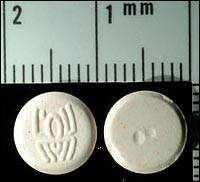5-Methoxy-N,N-diisopropyltryptamine (5-MeO-DiPT, sometimes called foxy methoxy or simply foxy[2]) is a psychedelic tryptamine and the methoxy derivative of diisopropyltryptamine (DiPT).
 | |
 | |
| Clinical data | |
|---|---|
| Trade names | Foxy, Foxy Methoxy |
| Legal status | |
| Legal status | |
| Identifiers | |
| |
| CAS Number | |
| PubChem CID | |
| DrugBank | |
| ChemSpider | |
| UNII | |
| KEGG | |
| ChEBI | |
| CompTox Dashboard (EPA) | |
| Chemical and physical data | |
| Formula | C17H26N2O |
| Molar mass | 274.408 g·mol−1 |
| 3D model (JSmol) | |
| Melting point | 181 °C (358 °F) |
| |
| |
| | |

Pharmacology
editThe mechanism that produces the purported hallucinogenic and entheogenic effects of 5-MeO-DiPT is thought to result primarily from 5-HT2A receptor agonism, although additional mechanisms of action such as monoamine oxidase inhibition (MAOI) may be involved also.[3] The strongest receptor binding affinity for 5-MeO-DiPT is at the 5-HT1A receptor.[4]
5-MeO-DiPT is neurotoxic in rats.[5][6][7]
Overdose
editExcessive doses have caused clinical intoxication, characterized by nausea, vomiting, agitation, hypotension, mydriasis, tachycardia and hallucinations, in a number of young adults. A number of these overdoses are attributed to the drug’s extended onset of action, where first time users, who were unfamiliar with the drug, administered a second dose after initially feeling no effects. Rhabdomyolysis and renal failure occurred in one young man and another one died 3–4 hours after an apparent rectal overdose.[8] At least one death has been attributed to consumption of 5-MeO-DiPT.[9]
Drug prohibition laws
editThis section needs additional citations for verification. (June 2019) |
China
editAs of October 2015 5-MeO-DiPT is a controlled substance in China.[10]
Denmark
editIllegal since February 2004.
Germany
editIllegal since September 1999.
Greece
editIllegal since February 2003.
Japan
editIllegal since April 2005.
Singapore
editIllegal since early 2006.
Sweden
editSveriges riksdags health ministry Statens folkhälsoinstitut classified 5-MeO-DiPT as "health hazard" under the act Lagen om förbud mot vissa hälsofarliga varor (translated Act on the Prohibition of Certain Goods Dangerous to Health) as of Oct 1, 2004, in their regulation SFS 2004:696 listed as 5-metoxi-N,N-diisopropyltryptamin (5-MeO-DIPT), making it illegal to sell or possess.[11]
United States
editOn April 4, 2003, the United States DEA added both 5-MeO-DiPT and alpha-methyltryptamine (AMT) to Schedule I of the Controlled Substances Act under "emergency scheduling" procedures. The drugs were officially placed into Schedule I on September 29, 2004. Prior to its prohibition in the U.S., 5-MeO-DiPT was sold online alongside psychoactive analogues such as DiPT, and DPT, neither of which have yet been expressly outlawed.
See also
editReferences
edit- ^ Anvisa (2023-07-24). "RDC Nº 804 - Listas de Substâncias Entorpecentes, Psicotrópicas, Precursoras e Outras sob Controle Especial" [Collegiate Board Resolution No. 804 - Lists of Narcotic, Psychotropic, Precursor, and Other Substances under Special Control] (in Brazilian Portuguese). Diário Oficial da União (published 2023-07-25). Archived from the original on 2023-08-27. Retrieved 2023-08-27.
- ^ Narimatsu S, Yonemoto R, Saito K, Takaya K, Kumamoto T, Ishikawa T, et al. (April 2006). "Oxidative metabolism of 5-methoxy-N,N-diisopropyltryptamine (Foxy) by human liver microsomes and recombinant cytochrome P450 enzymes". Biochemical Pharmacology. 71 (9): 1377–1385. doi:10.1016/j.bcp.2006.01.015. PMID 16510126.
- ^ Nagai F, Nonaka R, Satoh Hisashi Kamimura K (March 2007). "The effects of non-medically used psychoactive drugs on monoamine neurotransmission in rat brain". European Journal of Pharmacology. 559 (2–3): 132–137. doi:10.1016/j.ejphar.2006.11.075. PMID 17223101.
- ^ Ray TS (February 2010). "Psychedelics and the human receptorome". PLOS ONE. 5 (2): e9019. Bibcode:2010PLoSO...5.9019R. doi:10.1371/journal.pone.0009019. PMC 2814854. PMID 20126400.
- ^ Gołembiowska, Krystyna (2022). "Pharmacology and Neurotoxicity of 5-MeO-DIPT". Handbook of Neurotoxicity. Cham: Springer International Publishing. p. 1403–1414. doi:10.1007/978-3-031-15080-7_207. ISBN 978-3-031-15079-1.
- ^ Noworyta-Sokołowska K, Kamińska K, Kreiner G, Rogóż Z, Gołembiowska K (November 2016). "Neurotoxic Effects of 5-MeO-DIPT: A Psychoactive Tryptamine Derivative in Rats". Neurotoxicity Research. 30 (4): 606–619. doi:10.1007/s12640-016-9654-0. PMC 5047954. PMID 27461536.
- ^ Noworyta-Sokołowska K, Kamińska K, Rzemieniec J, Wnuk A, Wojcieszak J, Górska AM, Kreiner G, Kajta M, Gołembiowska K (2019). "Effects of exposure to 5-MeO-DIPT during adolescence on brain neurotransmission and neurotoxicity in adult rats". Forensic Toxicol. 37 (1): 45–58. doi:10.1007/s11419-018-0433-x. PMC 6315008. PMID 30636982.
- ^ Baselt R (2008). Disposition of Toxic Drugs and Chemicals in Man (8th ed.). Foster City, CA: Biomedical Publications. pp. 975–976.
- ^ Tanaka E, Kamata T, Katagi M, Tsuchihashi H, Honda K (November 2006). "A fatal poisoning with 5-methoxy-N,N-diisopropyltryptamine, Foxy". Forensic Science International. 163 (1–2): 152–154. doi:10.1016/j.forsciint.2005.11.026. PMID 16406422.
- ^ "关于印发《非药用类麻醉药品和精神药品列管办法》的通知" (in Chinese). China Food and Drug Administration. 27 September 2015. Archived from the original on 1 October 2015. Retrieved 1 October 2015.
- ^ "notisum.se" (PDF). Archived (PDF) from the original on 2013-09-29. Retrieved 2013-09-06.